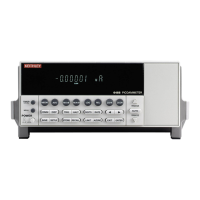8-8 Limit Tests Model 6485 Picoammeter Instruction Manual
B) FAIL?
In the event of a failure, you can read the measurement event register to determine which
limit (upper or lower) failed. See Section 11 to program and read the measurement event
register.
C) DATA?
The INITiate command must be sent to perform the programmed number of measure-
ments. If the instrument is programmed to perform a finite number of measurements, the
:DATA? command will return all the CALC2 readings after the last reading is taken. The
:DATA:LATest? command will only return the last (latest) CALC2 reading.
If the instrument is programmed to perform an infinite number of measurements (arm
count or trigger count set to infinite), you cannot use the :DATA? command to return
CALC2 readings. However, you can use the :DATA:LATest? command to return the last
CALC2 reading after aborting the measurement process. After sending the INITiate com-
mand to start the measurement process, use the ABORt command to abort the measure-
ment process, then use :DATA:LATest? to return the last CALC2 reading.
Sending :DATA? or :DATA:LATest? without first sending INITiate will return “old” read-
ings, or cause an error (-220) if limit is not enabled or there are no readings available.
D) ARM:SOURce <name>
Typical “start of test” options:
• IMMediate — Test starts when LIMIT key is pressed.
Programming example
The following command sequence will test DUT using the limit tests example shown in
Figure 8-2.
*RST ' Restore RST defaults.
CALC2:LIM:UPP 2e-3 ' Set upper limit for Limit 1 (2mA).
CALC2:LIM:LOW -2e-3 ' Set lower limit for Limit 1 (-2mA).
CALC2:LIM:STAT ON ' Enable Limit 1 test.
CALC2:LIM2:UPP 1e-3 ' Set upper limit for Limit 2 (1mA).
CALC2:LIM2:LOW -1e-3 ' Set lower limit for Limit 2 (-1mA).
CALC2:LIM2:STAT ON ' Enable Limit 2 test.
' Connect DUT to input.
SYST:ZCH OFF ' Disable Z Check.
INIT ' Perform tests on DUT (one measure-
ment).
CALC2:LIM:FAIL? ' Return result of Limit 1 test.
CALC2:LIM2:FAIL? ' Return result of Limit 2 test.

